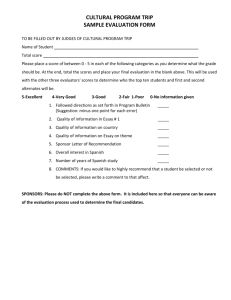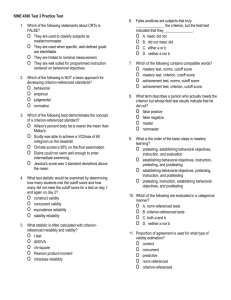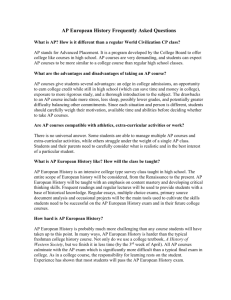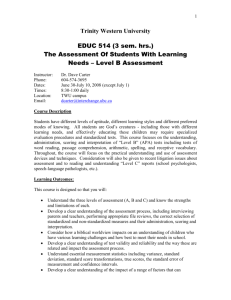Reading Guide, Cluster 14, Modules 38-40
advertisement
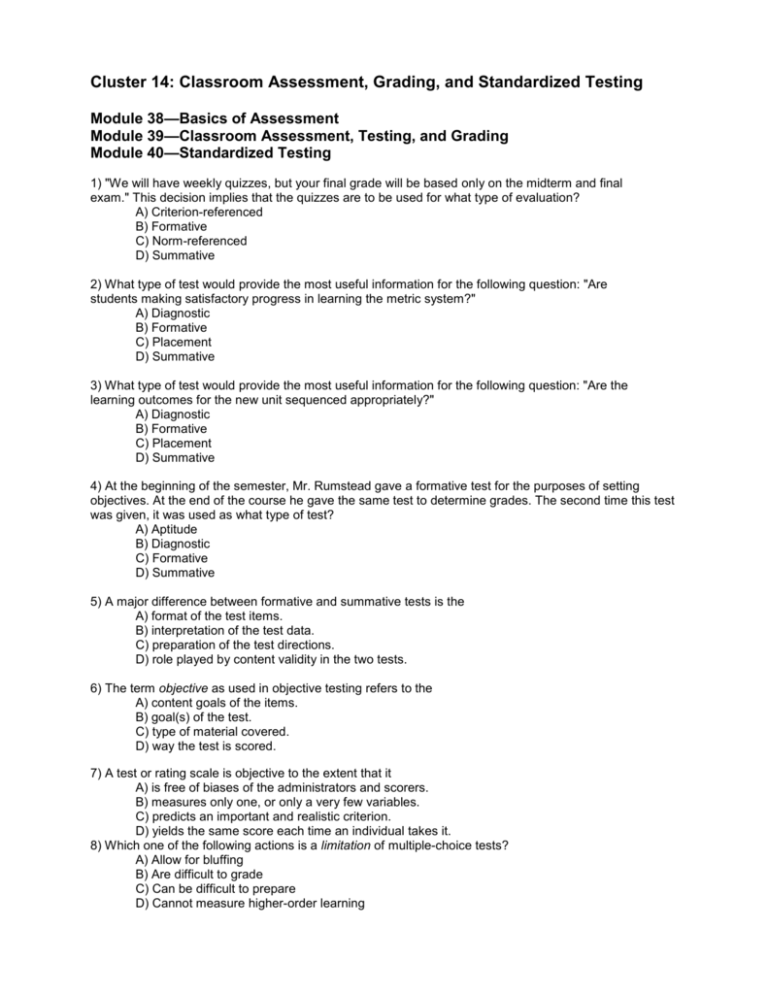
Cluster 14: Classroom Assessment, Grading, and Standardized Testing Module 38—Basics of Assessment Module 39—Classroom Assessment, Testing, and Grading Module 40—Standardized Testing 1) "We will have weekly quizzes, but your final grade will be based only on the midterm and final exam." This decision implies that the quizzes are to be used for what type of evaluation? A) Criterion-referenced B) Formative C) Norm-referenced D) Summative 2) What type of test would provide the most useful information for the following question: "Are students making satisfactory progress in learning the metric system?" A) Diagnostic B) Formative C) Placement D) Summative 3) What type of test would provide the most useful information for the following question: "Are the learning outcomes for the new unit sequenced appropriately?" A) Diagnostic B) Formative C) Placement D) Summative 4) At the beginning of the semester, Mr. Rumstead gave a formative test for the purposes of setting objectives. At the end of the course he gave the same test to determine grades. The second time this test was given, it was used as what type of test? A) Aptitude B) Diagnostic C) Formative D) Summative 5) A major difference between formative and summative tests is the A) format of the test items. B) interpretation of the test data. C) preparation of the test directions. D) role played by content validity in the two tests. 6) The term objective as used in objective testing refers to the A) content goals of the items. B) goal(s) of the test. C) type of material covered. D) way the test is scored. 7) A test or rating scale is objective to the extent that it A) is free of biases of the administrators and scorers. B) measures only one, or only a very few variables. C) predicts an important and realistic criterion. D) yields the same score each time an individual takes it. 8) Which one of the following actions is a limitation of multiple-choice tests? A) Allow for bluffing B) Are difficult to grade C) Can be difficult to prepare D) Cannot measure higher-order learning 9) What guideline for writing multiple-choice items is violated in the following item stem? "A norm referenced test is..." A) Each alternative must fit the grammatical form of the item. B) Item stems should be stated in simple terms. C) The stem should include a complete question. D) Unessential details should be omitted in the item stem. 10) When you write multiple-choice items, you should use A) as much wording as possible in the distractors. B) distractors that require fine discriminations. C) "none of the above" less frequently than "al l of the above." D) stems that present a single problem. 11) What is the most serious problem in the multiple-choice test item that you are now reading? A) Distractor responses should be clearly incorrect. B) Students should not have to discriminate between the alternative choices. C) The response choices include two distractors that essentially have the same meaning. D) The stem does not present a single, straightforward problem. 12) The most important use of essay tests is to A) measure simple learning outcomes. B) measure complex learning outcomes. C) reduce grading time. D) sample a wide variety of learning outcomes. 13) All of the following statements are true of essay tests EXCEPT: A) Each question should give students a precise task. B) Less material can be covered in essay than in multiple-choice tests. C) Students should be able to answer the questions in a few words for the sake of efficiency. D) Questions should measure the higher-level objectives. 14) Starch and Elliot's classic 1912 experiments dealing with the extent of teachers' personal values and biases in scoring essay tests demonstrated what measurement issue that still plagues essay scoring today? A) Objectivity B) Relevance C) Reliability D) Validity 15) What is the major problem in scoring essay tests? A) Difficulty with establishing time limits for responding B) Limiting the content covered compared to objective tests C) Restricting the tasks to more complex learning outcomes D) Subjectivity in assessing the learning products 16) The most defensible practice for scoring essay tests is to evaluate A) all parts of one student's paper before going on the next student's paper. B) each one of the items for al l students with reference to its respective model answers. C) each question as acceptable or unacceptable and assign equal weight to each question. D) the response for each question with regard to content, organization, and mechanics, with each factor weighted equally. 17) Which one of the following strategies does NOT tend to increase the reliability of essay test grades? A) Base your ratings on a model answer that you have constructed. B) Grade al l essay items for each student in turn based on a pre-established point system. C) Have students place their names on the back of their test papers. D) Score al l responses to one essay item before moving on to the next item. 18) Identify the type of objective test item that is most appropriate for measuring the following specific learning outcome: "Select the best reason for a specific action from a given list of alternatives. " A) Essay B) Multiple-choice C) Short-answer D) True-false 19) Objective tests are generally more reliable than essay tests because objective tests can A) be corrected for guessing a response correctly. B) contain more independent items measuring achievement. C) eliminate subjective judgment in their preparation. D) measure almost any important educational attainment. 20) The key feature of authentic assessments is A) development of tests by professional evaluators. B) high test-retest reliability. C) testing in a realistic context. D) use of essays as the primary form of testing. 21) Which one of the following procedures best reflects performance assessment? A) Making a class presentation that utilizes more than one medium to demonstrate the steps to follow in designing a specific communication B) Performing well enough on the SAT to obtain a combined Verbal and Quantitative score of at least 1080 C) Submitting a journal that will be evaluated on the basis of whether it contains notes for each class meeting D) Writing an essay on the "Republican Revolution" in the 1994 elections, citing primary social, economic, and political forces that led to this event 22) Which one of the following sources would be the LEAST likely product to be found in a student's portfolio? A) Artistic products B) Peer comments C) Standardized test results D) Written products 23) Exhibit ions differ from portfolios because exhibit ions A) are authentic assessments. B) involve an immediate audience. C) use criterion-referenced standards. D) use norm-referenced standards. 24) Which one of the following statements is TRUE regarding the use of portfolios in assessment? A) Criterion-referenced rather than norm-referenced grading should be used. B) Only positive samples of student performances should be selected for a portfolio. C) Portfolios work best with older students (middle or high school). D) Teachers rather than students should select the work to be included in the portfolio. 25) Which one of the following procedures would improve the reliability and validity of grading short essay tests, thus refuting the complaint of sensitivity to bias and variability in grading? A) Administering more pretests B) Grading on the curve C) Implementing a contract system D) Using a scoring rubric 26) A recommended procedure for authentic assessment is A) grading on the curve in order to determine overall performance scores. B) having students participate in developing the rating scales and scoring rubrics to be used in evaluation. C) using authentic testing initially with higher-achieving students, with gradual integration of other students. D) using only clearly defined, highly structured tasks or problems. 27) The basic difference between rating scales and scoring rubrics is that A) rating scales provide general descriptions of overall performance, while scoring rubrics provide specific feedback. B) rating scales provide norm-referenced interpretations of performance, while scoring rubrics provide criterion-referenced interpretations. C) scoring rubrics provide criterion-referenced interpretations of performance, while rating scales provide norm-referenced interpretations. D) scoring rubrics provide general descriptions of overall performance, while rating scales provide specific feedback. 28) A scoring rubric that permits raters to use a 50-point scale compared to using a five-point scale will tend to yield A) higher reliability. B) lower reliability. C) reduced variability in scoring. D) restricted validity in scoring. 29) Do evaluations of portfolios, exhibit ions, and other types of authentic assessment products have the same measurement concerns as those for classroom and standardized tests? A) No, because authentic assessments are constructed by the students themselves. B) No, because authentic assessments are inherently valid and fair to students. C) Yes, because authentic assessments have the same potential for invalidity and unfairness. D) Yes, because authentic assessments promote learning better than paper-and-pencil tests. 30) With regard to the practice of retaining or "holding back" students with failing grades, Woolfolk's general recommendation is that A) promotion should include resource room assignments as well as one-to-one tutoring when needed. B) promotion underscores the idea that poor performances bring negative consequences. C) retention is usually better for self-esteem and performance than undeserved promotion. D) students should be promoted with their peers but provided with extra help in the summer or the next year. 31) Ms. Bateman writes "the answer is just great" as the only comment on a student's paper. Based on Woolfolk's discussion of feedback, this type of feedback is A) less appropriate if Ms. Bateman is a tenth-grade teacher than a fourth-grade teacher. B) more appropriate if Ms. Bateman is a tenth-grade teacher than a fourth-grade teacher. C) more appropriate for an essay test than for a multiple-choice test. D) rarely appropriate regardless of grade level or type of test. 32) What strategy is recommended instead of assigning a failing grade to students' poor work? A) Consider the work to be incomplete. B) Give students support in revising the work. C) Maintain high standards for students' work. D) Take responsibility for the students' poor work. 33) Grades should be tied to meaningful course objectives so that A) high-ability students will be motivated to pursue worthwhile goals. B) low-ability students will be motivated to pursue worthwhile goals. C) students do not have to choose between learning and making a grade. D) the course objectives can be tested fairly and reliably. 34) Julie looked over her paper. She had a C- in spite of the fact that she tried as hard as she could to write an innovative paper. There did not seem to be any marks for mechanical errors on the paper. When she questioned her teacher about the grade, he told her, "You did not write your review of the story in the same way as the other students." The LEAST likely result of the teacher's actions will be to A) decrease Julie's attempts to be more creative. B) develop a poor self-concept in Julie. C) increase Julie's efforts to be creative. D) make Julie give up studying for this class. 35) Which one of the following procedures is recommended for reducing the detrimental effects of grading on students? A) Favor norm-referenced over criterion-referenced grading. B) Give ungraded assignments in order to increase exploration. C) Stop giving partial credit for "almost" correct answers. D) Use only one type of item (multiple-choice or essay) on a given test. 36) A typical criterion-referenced report card that reports student learning tends to be A) complex and time-consuming for teachers. B) constructive for group comparisons. C) convenient but not helpful for many students. D) practical for elementary grades but not for high school. 37) On five tests that involve different numbers of items, Bill 's total raw score was 430, and Diane's total raw score was 440. Under what type of grading system is the possibility greatest that Bill could earn an A and Diane only a B? A) Criterion-referenced grading B) Norm-referenced using average T-scores C) Percentage grading D) Point system 38) When teachers want to give different weights to tests and assignments, it is most appropriate to use a what type of grading system? A) Criterion-referenced B) Normal curve C) Percentage D) Point or norm-referenced 39) A popular grading system to use for combining grades from many assignments is to use A) an average of the grades from all sources. B) an average of al l of the norm-referenced scores. C) a point system. D) percentage grading. 40) The type of skills that would be most effective for teachers to have in conducting conferences with students and their families is skill in A) academic knowledge. B) communication. C) creativity. D) problem solving. 41) The fundamental purpose of educational assessment is to A) determine the quality of the outcomes being judged. B) identify which programs or people are superior to others. C) obtain objective data that express performances in quantitative terms. D) provide information to support decision-making. 42) Paper-and-pencil exercises, direct observations of performances, development of portfolios, and creation of artifacts are all methods of A) assessment. B) evaluation. C) measurement. D) testing. 43) Which one of the following situations requires a norm-referenced evaluation? A) Assessing whether an individual has been drinking too much to drive B) Certifying whether a newly graduated education student can perform satisfactorily as a teacher C) Hiring one manager from a pool of ten applicants for a large department store D) Reporting to parents about how much students have learned during the semester 44) A local high school developed a math achievement test and used the results to determine the selection of students for an advanced placement course with a limited number of seats. What type of test should be used? A) Criterion-referenced B) Diagnostic C) Norm-referenced D) Standardized 45) A teacher who is interested in finding out how well a student is doing in class compared to students in other schools should use what type of test? A) Criterion-referenced B) Diagnostic C) Norm-referenced D) Teacher-designed 46) Criterion-referenced tests are used primarily to assess A) achievement of general instructional goals. B) each student's achievement compared to other students. C) mastery of specific objectives. D) the range of achievement in a large group. 47) A school administrator wants to identify the top 10 percent of the senior students in order to recommend them for scholarship competition at the highest rated university in the state. What testing purpose would serve the administrator's purpose? A) Criterion-referenced B) Diagnostic C) Norm-referenced D) Standardized 48) For which one of the following situations would a criterion-referenced test be the most appropriate measure to use? A) Assessing the range of abilities in a large, mixed-ability group of students B) Comparing students' general ability in specific subject areas such as English, algebra, or general science C) Measuring mastery of basic competencies in addition and subtraction D) Selecting candidates for a teaching position when only a few openings are available 49) Which one of the following student outcomes is MOST likely to be the result of a criterion referenced assessment tool? A) Anita was the first student to complete the test. B) Ben answered 10 out of 12 questions correctly. C) Randy scored at the eighty-ninth percentile. D) Sonia ranked fifteenth in French and ninth in music. 50) The most important attribute of a norming sample is that it should be A) completely random. B) large and diverse. C) limited in size. D) similar to future test-takers. 51) What is the arithmetic mean of the following set of scores? Scores: 0, 13, 15, 16, 16 A) 12 B) 13 C) 14 D) 15 52) Rob scored exactly in the middle of his class on the social studies exam. A valid interpretation of Rob's performance is that he scored exactly at the A) center of a symmetrical frequency distribution. B) mean of the class. C) median of the class. D) mode of the class. 53) What is the median for the following set of scores? Scores: 66, 66, 74, 96, 98 A) 66 B) 74 C) 78 D) 80 54) The relationship between the standard deviation and test scores is that the larger the standard deviation, the A) greater the variability in the distribution. B) higher the central tendency. C) lower the variability in the distribution. D) narrower the distribution of scores. 55) A standard deviation is a measure of A) how well the students met the tested objectives. B) the distance between the median and the extreme scores. C) the spread of scores around the mean. D) the level of validity for the test. 56) The Algebra I class mean and standard deviation are 80 and 10, respectively. The Biology II class mean and standard deviation are 79 and 4, respectively. Kristen scored 90 in Algebra I and 87 in Biology II. The most valid conclusion to be drawn from these data is that Kristen A) scored better relative to her class in Algebra I than in Biology II. B) scored better relative to her class in Biology II than in Algebra I. C) should earn an A in Algebra I and a B in Biology II. D) would be served better by criterion-referenced grading than by norm-referenced grading in both courses. 57) Mr. Skiebert gave the same physics test to each of his three senior classes. Analysis of the data revealed the following descriptive statistics: Class Mean Standard Deviation One 59 7.5 Two 68 6.2 Three 62 6.9 Compared to the two other classes, Mr. Skiebert can infer that students in Class One exhibit A) a narrow distribution of scores. B) greater variability. C) higher central tendency. D) lower variability. 58) On the midterm, Ms. Gomez' first-period class had a mean of 79.5 and a standard deviation of 5. Her third-period class had a mean of 81.7 and a standard deviation of 17. Given only this information, what inference can be made? A) The first period is more difficult to teach than third period. B) The midterm was probably too difficult for both classes. C) The third period is more difficult to teach than first period. D) The two classes seem to be fairly equal in abilities. 59) Approximately what percentage of the scores in a normal distribution is higher than one standard deviation above the mean? A) 2.5 percent B) 16 percent C) 34 percent D) 68 percent 60) In a normal distribution of scores, approximately what percent of the z-scores will be negative? A) 0 B) 25 C) 50 D) Cannot determine from the information given. 61) In a normal distribution, which one of the following measures of central tendency will have the highest value? A) Mean B) Median C) Mode D) The central tendencies will be equal. 62) A percentile rank score of 70 means that the student A) answered a majority of the questions correctly. B) had 70 correct answers on the test. C) scored as well as or better than 70 percent of all the test-takers. D) scored at the seventh-grade level compared to other students. 63) Jennifer, a seventh grader, received a percentile rank of 90 on a standardized vocabulary test. This percentile rank indicates that she A) exceeded the eighth-grade performance level. B) is as advanced as a ninth grader. C) scored above the average for seventh graders. D) should be assigned a grade of A for her performance. 64) Mart in scored in the top 15 percent of his remedial reading class. If the norming group had included the regular and advanced students in his school, Martin's percentile rank would have been A) higher. B) lower. C) similar. D) unpredictable. 65) Sam, a seventh grader, received a grade-equivalent score of 9.2 on a standardized vocabulary test at the end of the spring term. This result indicates that Sam A) achieved about the same level as the average ninth graders in the norms group. B) knows as much vocabulary as the typical ninth grader in the norms group. C) scored above average compared to seventh graders in the norm group. D) should be awarded a grade of A for his achievement in vocabulary. 66) The Public Speaking Aptitude Test (PSAT) scores are reported for four students from their respective high schools. However, different standard scores were reported for each. Assuming that al l scores were based on a raw score normal distribution, which student has the highest score? A) Angie: T-score = 57 B) Bart: z-score = +1.33 C) Kris: stanine = 5 D) Larry: SAT-type score = 550 67) In a normal distribution, a T-score of 60 is equal to approximately what percentile rank? A) 60 B) 84 C) 95 D) 99 68) What score-reporting method decreases competition among students by representing the widest range of raw scores? A) Percentile ranks B) Stanines C) T-scores D) z-scores 69) Assuming that the raw scores are distributed normally, which one of the following standard scores indicates the best performance relative to the group being tested? A) Percentile rank of 60 B) Stanine score of 8 C) T-score of 59 D) z-score of +. 70) Kathy took the Stanford Achievement Test on Monday and again on Friday. Her two scores differed by only three points. These results may indicate a good level of what type of reliability? A) Alternate-form B) Internal consistency C) Split-half D) Test-retest 71) The precision of a test refers to test reliability as measured by what method? A) Alternate-form B) Internal consistency C) Split-half D) Test-retest 72) One of the most efficient and effective ways to increase the reliability of a test is to A) have more than one person grade the test. B) keep the test brief. C) lengthen the test. D) provide ample response time. 73) Which one of the following definitions best describes "true score"? A) Confidence score if the test were perfectly reliable B) Hypothetical score on a student's best day C) Observed raw score plus the confidence score D) Obtained raw score minus measurement error 74) Jerry scored 81 on a test. The mean of this test was 70, the standard deviation was 10, and the standard error of measurement was 2. Given these data, we can be reasonably certain (2 times out of 3) that Jerry's true score would be in the range from A) 71 to 91. B) 75 to 85. C) 77 to 87. D) 79 to 83. 75) On standardized tests, a difference of a few points between two raw scores is likely to be insignificant due to the A) central limits theorem. B) confidence interval for the scores. C) equivalence reliability of the tests. D) probability of chance. 76) The validity of any test is related directly to the A) difficulty of the test. B) evaluation of expert reviewers. C) length of the test. D) purpose of the test. 77) When a test actually measures what it purports to measure, the test is said to be A) credible. B) reliable. C) usable. D) valid. 78) If a thermometer measured an oven's temperature as 400°F for five days in a row when the temperature was actually 350°F, this measuring instrument would be A) both reliable and valid. B) both unreliable and invalid. C) reliable but not valid. D) valid but not reliable. 79) After administering a standardized test of reading comprehension, scores are compared to teacher estimates of reading comprehension for each student. What particular technical concern of measurement is involved in this comparison? A) Commonality B) Discrimination C) Reliability D) Validity 80) The evidence for validity that concerns whether the test measures the trait in question rather than some other trait is what type of evidence? A) Construct-related B) Content-related C) Criterion-related D) Test-retest 81) What type of validity is currently thought to include all other types of validity? A) Content-related B) Construct-related C) Criterion-related D) Prediction-related 82) The connection between validity and reliability can be best expressed by the statement that validity A) is essentially the same as reliability. B) requires and may be assured through reliability. C) requires but cannot be assured through reliability. D) requires only a limited reliability. 83) Fred made 103 and Frank made 96 on an achievement test with a confidence interval of 4. These results indicate that A) Fred's true score is definitely higher than Frank's true score. B) measurement error can account for the differences in their scores. C) the true scores of each student are probably very close. D) the test used to generate these scores must be very reliable. 84) IQ scores are normally distributed with a mean of 100 and a standard deviation of 15. Based on properties of the mathematical normal curve, which one of the following statements is TRUE? A) Approximately 90 percent of the scores fall between 85 and 115. B) A score of 70 is equally as probable as is a score of 130. C) There are more scores above 130 than below 85. D) There are more scores above the mean than below the mean. 85) What is the major issue underlying high-stakes testing? A) A decreased emphasis on standardized testing in favor of authentic testing B) An increased dependence on standardized tests for decision making C) The relatively high expense of testing large numbers of students D) The lack of validity of many standardized tests in use today 86) Molly is preparing to take a standardized test that will be used by administrators to evaluate the type of school placement she should have. What type of assessment is Molly involved in? A) Criterion-referenced B) High-stakes testing C) Norm-referenced D) Standardized aptitude testing 87) A test or any assessment instrument is objective to the extent that it A) is free of biases of the test administrators and scorers. B) measures only a very few variables at a time. C) predicts an important and realistic criterion. D) yields the same score each time an individual takes it. 88) Research on bias in testing indicates that standardized tests predict school achievement A) equally well for al l groups of students. B) equally well for white, English-speaking students. C) very accurately for only a small percentage of students. D) very accurately for high SES students in al l ethnic groups. 89) Students from minority groups in deprived socioeconomic backgrounds who have taken culture-fair tests have generally performed A) better than other minority groups on standardized tests. B) better than their non-deprived peers but worse than non-minority groups. C) on par with or even worse than their own performances on other types of standardized tests. D) worse than their non-deprived peers if the test was individually administered. 90) Mr. Garren has been emphasizing authentic testing in his social studies class. Which one of the following will be a likely result of this emphasis? A) Fewer essay tests B) More exhibit ions by students of their work C) More mastery grading of performances D) More reliable grading of students

